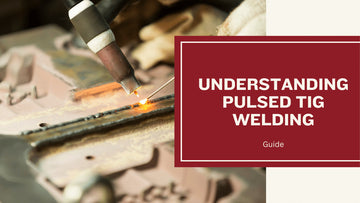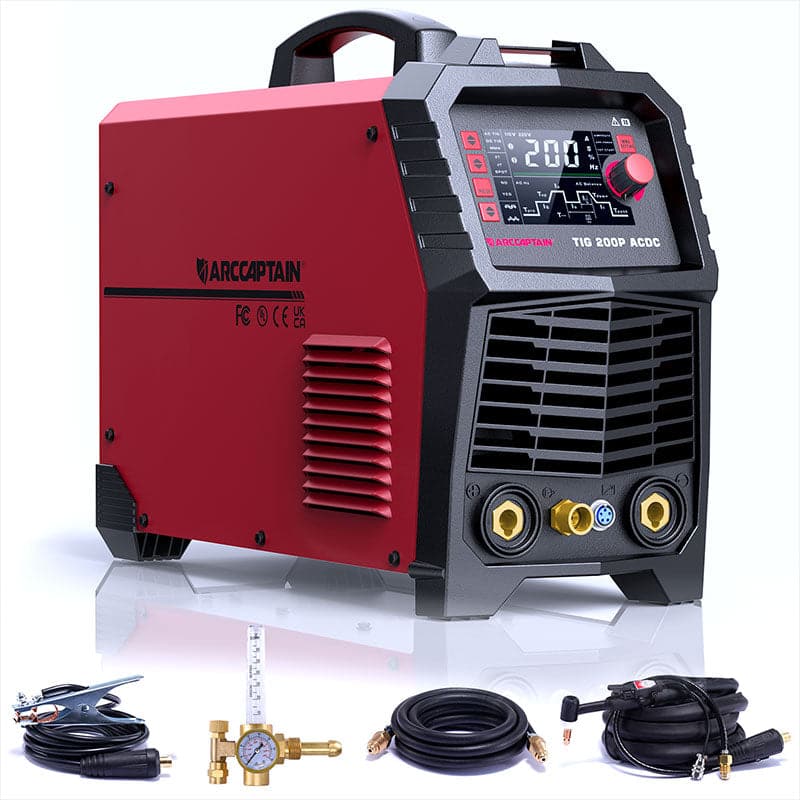
If you're looking to improve your welding skills, pulsed TIG welding is a technique you may want to consider. This welding process creates deeper penetration while reducing the heat input into the metal, resulting in flawless, smooth, deeply penetrating welds, even on thin gauge materials without burn-through.
In this article, we'll discuss what pulsed TIG welding is and how it works. We'll also cover how to set it up, its advantages and disadvantages, and how to apply it to different metals. Whether you're a beginner or an experienced welder, understanding pulsed TIG welding can help you achieve a higher level of precision and quality in your work.
What is Pulsed TIG?
Pulsed TIG welding is a TIG process that uses an advanced heat input control mechanism to produce high-quality welds. It allows welders to control the amperage output of the TIG welder by setting the maximum amperage, minimum amperage, and frequency of how many times the output alternates between the two. This creates a pulsed waveform instead of a steady stream of electrical current, hence the name "pulsed TIG."
Pulsed TIG welding is ideal for welding thin gauge materials, such as sheet metal and base metal. It is also commonly used for welding aluminum and stainless steel, particularly 304 stainless steel. With pulsed TIG welding, the operator would still control the amperage output with a foot pedal, but the amperage output from the TIG torch is a pulsed waveform instead of a steady stream of electrical current.
The pulsed TIG welding process has many advantages over traditional TIG welding. It improves weld penetration while lowering the heat input, resulting in a cleaner, more precise weld. It also reduces the risk of burn-through and distortion, making it ideal for welding thin gauge materials.
In summary, pulsed TIG welding is an advanced TIG process that uses pulse welding to produce high-quality welds. It is ideal for welding thin gauge materials, such as sheet metal and base metal, as well as aluminum and stainless steel. The pulsed TIG welding process improves weld penetration while lowering the heat input, resulting in a cleaner, more precise weld.
How Pulsed TIG Works?
Pulsed TIG welding is a method that alternates between high and low electric current to join metals effectively. This technique enhances weld penetration while minimizing the overall heat applied to the metal, ensuring better quality with less heat damage. To use this method, you need to adjust several settings: peak amperage (the highest current in a pulse), background amperage (the lowest current), pulse width (how long the peak current is applied), and pulse frequency (how many pulses occur per second).
Adjusting these variables depends on factors like the type of material, its thickness, the speed of welding, the desired appearance of the weld, and the welding position. For example, setting an ARCCAPTAIN TIG welder for one pulse per second with specific amperages and pulse widths results in the welder alternating between these settings in the given time frame. Similarly, if the settings are for 200 pulses per second, the welder switches between high and low currents rapidly within each second.
Pulsed TIG welding is particularly beneficial for stainless steel, enhancing efficiency and lowering welding costs. It's important to select the right settings for peak and background amperage, pulse frequency, and pulse width based on the welding task at hand, ensuring optimal welding performance.
Advantages of Pulsed TIG Welding
Pulsed TIG welding is a versatile process that offers many advantages over traditional TIG welding. In this section, we will explore some of the key benefits of pulsed TIG welding.
Improving Heat Input Control
One of the most significant advantages of pulsed TIG welding is the improved control over heat input. Welding thin materials can be challenging due to the risk of warping and distortion. However, pulsed TIG welding allows you to manage heat input more effectively, resulting in fewer failed welds and less need for rework. By reducing the duration of the peak pulse current and increasing the frequency of switching between the pulses, you can drastically reduce the heat input. This improves heat management and reduces the chance that the thin gauge will distort, discolorize, or lose corrosion resistance. Additionally, at higher pulse frequency, the heat-affected zone becomes narrower, preventing unnecessary heat loss into the surrounding metal and letting you focus the arc where it matters — in the joint.
Improved Penetration and Travel Speed
Pulsed TIG welding offers improved penetration and travel speed. The higher pulse frequency you use, the more constricted the arc becomes, and the deeper the weld penetration is achieved. So, if you need to weld thick metal, it’s helpful to crank up the frequency and keep the background amps somewhere around 50% of the peak amperage. But, the exact settings depend on the material, thickness, and other variables. Apart from improved penetration, you can also weld faster with higher pulse settings. Anything above 100Hz (100 PPS) improves your welding speed. This is useful when welding thick or thin chromoly or other sensitive metals.
Out Of Position Welding
Pulsed TIG welding is particularly useful for out-of-position welding, where gravity can cause the weld puddle to fall on your welding helmet. Lowering the duration of the peak amperage time can keep the weld chill enough to prevent an overly liquid puddle. You can also try increasing the pulse setting and lowering the peak amperage. This will achieve penetration thanks to the focused arc but shouldn’t liquify the puddle too much thanks to the lower amperage. This does depend on the metal, so it takes some tweaking until you dial in the right pulse settings.
Improved Weld Quality
Pulsed TIG welding produces a special ripple effect in the weld puddle, also referred to as weld agitation. This ripple effect benefits the joint by preventing contaminants from getting stuck underneath the weld by disrupting the surface tension, and it fills the joint more evenly. Many industrial welding processes use weld agitation, so having the ability to experience something similar with an inverter TIG welder is very helpful.
Enhanced Weld Looks
Pulsed TIG welding is often responsible for those phenomenal TIG welds welders put up on their Instagram profiles. Pulsing makes achieving a stacked dimes weld look much easier because you have a visual guide — as the amperage switches, the arc gets dimmer and then brighter again. It’s easy to catch the rhythm and dab the wire accordingly. Additionally, it’s possible to make an additional pass without a filler metal over a previously laid weld. By using lower amperage and high pulse settings, you can melt just the face of the weld and smooth it out if that’s necessary. As a result, you’ll decrease your post-welding surface preparation time.
Welding Near Edges or Holes
Pulsed TIG welding makes welding edges or making welds near holes easier. By lowering the average heat input with pulsing, you’ll improve your chances of maintaining a proper edge. The process also makes it possible to weld thinner materials with ease, which is normally difficult by the standard TIG process.
In summary, pulsed TIG welding offers many advantages that can improve your welding productivity, cut costs, and improve the quality of your welds. By improving heat input control, penetration, travel speed, and weld quality, you can achieve better results in less time.
The Main Disadvantage Of Pulsed TIG
The main disadvantage of pulse TIG welding is the learning curve. If you are a beginner TIG welder, it may take some time to get the hang of pulse welding. Feeding the wire into a pulsed arc requires some skill development, which can be challenging for those new to welding.
However, with enough practice, anyone can learn how to perform pulsed TIG welding. It is worth the effort to learn this technique, as it offers many benefits over traditional TIG welding.
One way to ease into pulsed TIG welding is to first learn how to perform regular TIG welding and develop your style. This will give you a strong foundation to build upon when you start introducing pulsed TIG into your work.
Another way to experience a basic pulsed TIG if you don’t have a pulse-capable welder is to use a foot pedal to simulate it. This is a good way to start practicing pulse welding before getting a TIG machine that supports this feature. Set your low and high amps for the pedal and perform a simple 1Hz (1 PPS) by pressing and releasing the pedal once per second.
In conclusion, the learning curve is the main disadvantage of pulse TIG welding, but with practice and patience, anyone can learn how to perform this technique and enjoy its many benefits.
See our best-selling PULSE TIG Welder Machine:

Conclusion
Correctly setting the pulse settings for Pulsed TIG welding is a matter of experience and trial and error. However, a high pulse frequency results in a narrow and focused arc with deep penetration. Moreover, reducing the difference between high and low amperage and reducing the time on high amps reduces heat input and increases penetration. This technique is perfect for improving welding speed, penetration, and weld looks while minimizing heat input. When the pulse settings are correctly set, you'll experience the best of both worlds, penetration with a lowered heat input. With practice and attention to detail, you can master Pulsed TIG welding and achieve the desired results.
Frequently Asked Questions
What are the benefits of using pulse TIG welding over traditional TIG welding?
Pulse TIG welder provides several benefits over traditional TIG welding, such as:
- Improved weld quality
- Reduced heat input
- Better control over the weld puddle
- Reduced distortion
- Better penetration
- Reduced spatter
- Ability to weld thin materials
How do you adjust pulse settings for optimal TIG welding performance?
To adjust pulse settings for optimal TIG welding performance, you need to consider the following factors:
- Material type and thickness
- Joint type
- Welding position
- Welding speed
- Welding current
- AC balance
- Pulse frequency
- Pulse width
- Peak amperage
- Background amperage
Can pulse TIG welding be effectively used for welding aluminum?
Yes, pulse TIG welding can be effectively used for welding aluminum. However, it requires a different approach than welding other materials. When welding aluminum, you need to use a higher frequency and a lower peak amperage to prevent burn-through.
What does AC balance mean and how does it affect TIG welding outcomes?
AC balance refers to the amount of time that the electrode is positive versus negative during TIG welding. It affects TIG welding outcomes by controlling the amount of cleaning and penetration that occurs during welding. A higher AC balance will result in more cleaning action, while a lower AC balance will result in more penetration.
What common issues should I look out for when pulse TIG welding?
Common issues that you should look out for when pulse TIG welding include:
- Burn-through
- Porosity
- Incomplete fusion
- Cracking
- Warping
- Tungsten contamination
- Poor bead appearance
How does high frequency affect pulse TIG welding processes?
High frequency affects pulse TIG welding processes by ionizing the air between the electrode and the workpiece, which creates a stable arc and prevents arc wandering. It also helps to initiate the arc and maintain arc stability at low amperages. However, too high of a frequency can cause interference with electronics and radio equipment.
